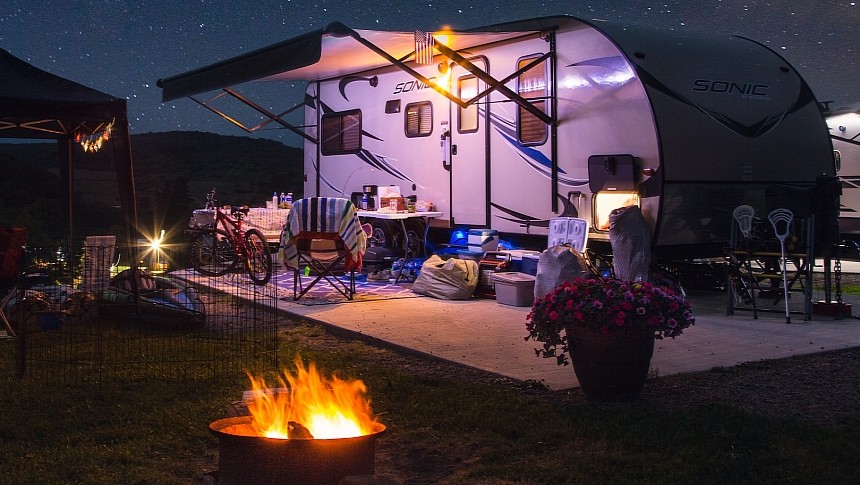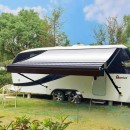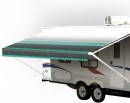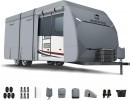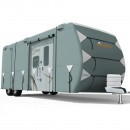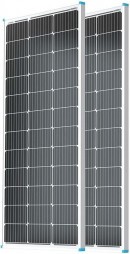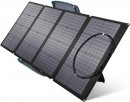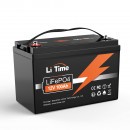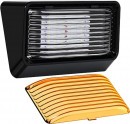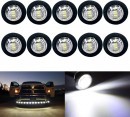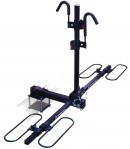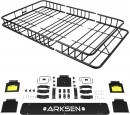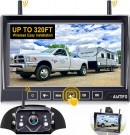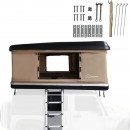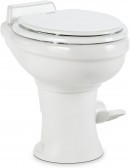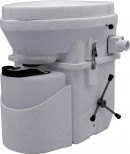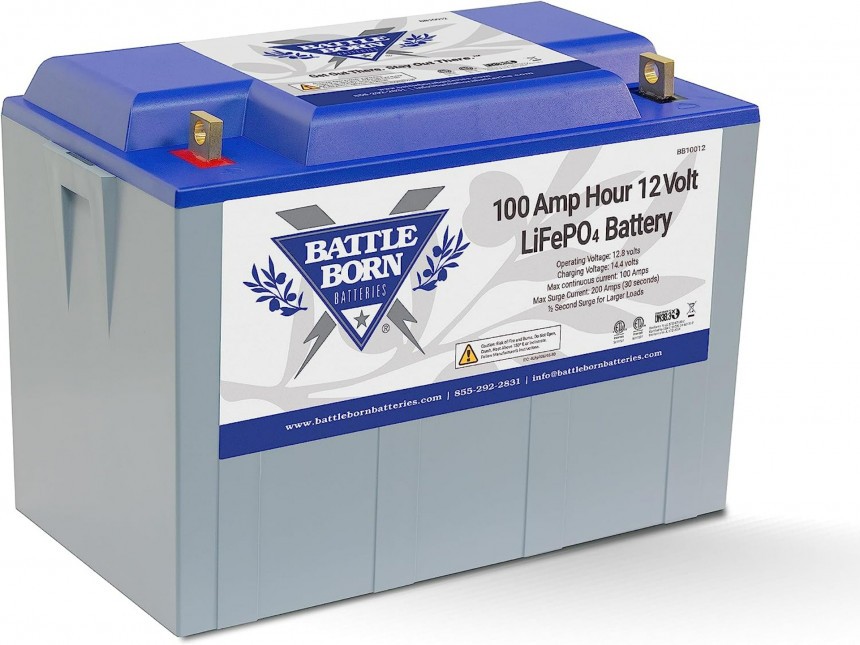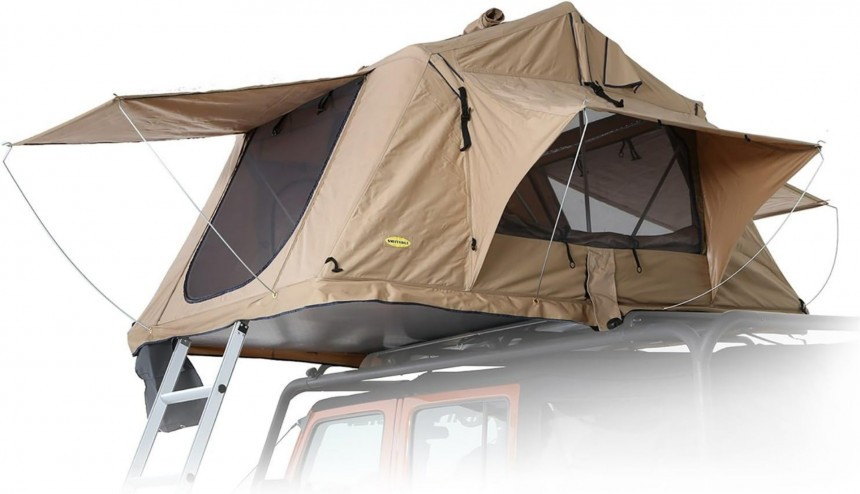1. Awnings
Another benefit of using an awning is that it expands your living space, especially when traveling in tiny campers. Moreover, this way, you get to enjoy more outdoor entertainment and dining experiences.
Awnings come in all sorts of shapes and sizes, so finding a product that suits your needs won't be difficult. You can get a retractable awning that can be used and retracted as needed. There are even automatic awnings that do the extending work for you at the press of a button. They're the most popular option, fitted as standard on the side of modern RVs and campers.
If that's not what you're looking for, you might want to consider a standalone awning – as its name suggests, you can set it up separately from your vehicle.
Manufacturers typically refer to the vinyl fabrics used in awnings by weight. For instance, a 13-oz vinyl fabric is generally considered good, but a better option would be the 15-oz or 16-oz variants. Moreover, the more plies, the better protection and durability you'll get.
It's not enough to get your hands on a high-quality awning. To ensure it will last throughout the years, you'll need to carry out proper maintenance, such as cleaning it and applying special waterproofing sprays once every other year.
By dishing out $600, you can get your hands on the manual-operated Awnlux awning, available in many colors and sizes from 10 to 20 feet (3 to 6.1 meters). The awning fabric is produced from high-quality 16oz vinyl material, fully waterproof and thermally insulated. Moreover, there are two "Usage Scene Modes," as the manufacturer calls them. Basically, it's up to you if you want to mount the awning on the RV or separately, with the possibility of switching between these two modes.
If you've already got an awning with lots of wear and tear that needs a replacement, you might want to take a look at the SunWave awning fabric. Just like the one above, many sizes are available, and you'll have to pay $150 for it. The canopy is made of 15-oz vinyl resistant to UV radiation, with a tensile strength of 140 PSI. It's also flame-retardant and will not crack in low temperatures. Furthermore, the manufacturer claims it will take long for the color to fade, as it's color-coated on both sides.
2. Covers
If you've got solar panels, it's all the more important to make sure your RV is protected. By the way, the cover isn't just for your vehicle's roof – they're designed to protect its sides and tires.
Here are some tips and tricks regarding RV covers. Never use something as a cover if it wasn't specifically engineered for it. Moreover, make sure it's made from a high-quality, breathable material to prevent mold and mildew.
If you'll leave the RV covered for months on end, ensure the vehicle is clean before you protect it. You can even go the extra mile and give it a wax job or a pricier detailing job. Just make sure the EV is not dirty before you cover it.
Lastly, ensure the cover is correctly attached to your vehicle. If not, dirt can get under it, and the wind might cause it to flap, possibly damaging the exterior finish in time.
One of the best-selling RV covers on Amazon is the Vinpatio heavy-duty RV cover, suitable for vehicles from 14 to 38 feet (4.3 to 12 meters) long. This cover features a seven-ply, non-woven fabric with a built-in waterproof membrane and a UV-resistant coating. There are four rollable zippered floors, three on the side and one at the rear. Furthermore, you also get a range of practical accessories for mounting the cover, such as windproof straps, all for a total price of $225 for the 20-22 feet (6.1-6.7 meters) variant.
The King Bird cover can be bought in sizes 18 feet to 38 feet (5.5 to 12 meters) for a bit more than the Vinpatio, $245 for the 20-22 feet model. It features five extra-thick layers, waterproof and tearproof. What's nice about this product is that it comes with six air vents on both sides, designed to reduce wind stress. Moreover, you can access the RV doors and engine area via rollable zipped doors.
3. Solar Panels
Luckily, solar panels can save the day, providing "free" energy and reducing your costs on fuel and plug-in charges. Furthermore, they help keep the batteries healthy, doubling and even tripling their lifespan.
By switching to solar power, you also reduce your carbon footprint. So, fitting solar panels on your RV is undoubtedly a wise investment. It's up to you if you want to get fixed solar panels on the roof or a foldable setup.
Most solar panels for RVs or campers have between 100 and 400 W of power. They function the same way as a residential solar panel setup does. That means you'll need several other components to make everything work, including batteries, a charge controller, an inverter/ charger, and more. Taking everything into consideration, it will cost you between $600 and $2,000 for a complete RV solar panel system.
First up, we have the 100 W 2-pack solar panels from Renogy. These 12 V monocrystalline solar panels provide an output of an average of 500 Wh of electricity daily, of course, depending on the sun's availability. They're compact and lightweight, tipping the scales at a mere 14.1 lbs. (6.4 kg), yet they still boast 22% efficiency. You get full IP65 protection with these solar panels, meaning they can handle snow, rain, and heat with no issues. Renogy offers a 10-year warranty and claims the solar panels deliver more than 80% at 25 years. There are more powerful options available at a higher cost.
If you don't want to mount solar panels on your vehicle's roof, you can check out a portable solar panel just like this one from EcoFlow. These 160 W solar panels weigh just 1.4 lbs. (7 kg) and have a high conversion efficiency of 21-22%. EcoFlow made sure to make these solar panels as durable as possible with an IP68 rating.
EcoFlow offers a case that protects the solar panels when transporting them to sweeten the deal. The cool thing is that this case also doubles as a kickstand, so you're able to position the panels in any direction or orientation, meaning you'll get more power than if you were to lay them flat.
4. Li-Ion Batteries
Lithium-ion batteries are more durable than other RV batteries because they do not degrade as quickly as lead-acid batteries or nickel-cadmium (NiCad) batteries do.
On top of that, Li-Ion batteries hold more energy than other batteries and require very little maintenance compared to traditional lead-acid batteries. A lead-acid battery can store around 25 watt-hours per kilogram of battery, whereas a lithium-ion battery can store 100 to 265 watt-hours per kilogram.
Moreover, they're easier to transport as they're lighter than other battery versions yet still provide a consistent voltage.
So, when it comes to tiny homes on wheels, Li-Ion batteries will be your go-to, especially since they last around ten years before they start losing capacity. The only downside when it comes to Li-Ion batteries is that they cost significantly more than other types of batteries, but it'll be worth it in the long run.
I write regularly about RVs and campers, and I noticed one of the names that keeps popping up regarding batteries is Battle Born. One option is this 100 Ah, 12 V battery, priced at $925. BattleBorn batteries cost more than other brands, but you'll enjoy a great return on your investment. This model can be wired in series or parallel and lasts 3,000 to 5,000 deep discharge cycles, with an estimated life of over a decade. As its name suggests, this battery is ready to tackle harsh conditions, such as extreme temperatures.
Another excellent, more affordable choice is this LiTime 100 Ah, 12 V battery, currently offered for $280. It's estimated to provide between 4,000 and 15,000 cycles and weighs just 24.3 lbs. (11 kilograms) for one module. Moreover, it comes with an IP65 rating and an estimated 10-year lifetime.
5. Exterior Lights
That being said, you need to choose your fixtures wisely, as they can slowly drain your battery. Or, you can go for solar-powered ones and use them worry-free.
Most newer RVs and campers come with LED lights because they last longer, use less energy, and don't generate heat. The only downside is that they're a bit more expensive.
You don't need to go too crazy with lights on your vehicle. That's why a simple and inexpensive solution could be this Leisure LED RV light, priced at a mere $9.5. It features a rectangle shape and has a beam pattern of 120 degrees, with a Cool White color temperature and 280 lumens. Moreover, its manufacturer claims the light has a 60,000-hour life expectancy.
Instead of going for a single larger light, you can go for multiple smaller ones. One option could be the Keing 10-pack waterproof lights, offered for just $9.6. Measuring a mere 0.75 inches (1.9 centimeters), these lights will fit pretty much anywhere. You can put them on the front bumper, under the awning, or wherever you please. The great thing about these is that they feature IP68 protection. Moreover, they're effortless to install, with just a 2-wire connection. According to the manufacturer, these lights will last more than 100,000 hours.
6. Bike Racks
There are several types of bike racks available. There are ladder-mounted racks for larger RVs that have a ladder attached at the rear. Even though they're a viable option, you can only carry a few bikes, and you'll have the ladder blocked off when you're not riding.
Next up, we have bumper-mounted racks. Not all campers support these, but they're sturdier than ladder-mounted racks.
If you're looking to carry multiple bikes, check out hitch-mounted racks, provided your mobile home features a trailer hitch (most do). They're the best option, as they can hold the most weight. Moreover, this bike rack can also be used on a regular car, so you can use it when you're not camping.
I recommend purchasing a secure lock to keep your bike safe, especially when spending the night at a campsite. You don't wanna leave any window of opportunity for ill-intended people to get their hands on your bikes.
Another thing you should be looking for is making sure your bike rack is RV-approved. That means it can support continuous vibrations and jolts when driving and be tough enough to handle significant weight and harsher weather elements.
Swagman is, at heart, an RV-building company. Using their expertise in the mobile home sector, they also offer various mount racks. One of them is the Swagman Traveler XC2 bicycle carrier, available for $219. Swagman designed this piece of equipment to be compatible with various sizes of trailers and campers. It can carry up to two bikes. What's more, it tips the scales at 39 lbs. (18 kg) and can be folded when not in use.
I wanted to provide an option for those looking to attach their bike somewhere besides the rear. The Jack-It double bike carrier system from Let's Go Aero mounts over the tongue jack and connects directly to your A-Frame trailer. The front of the trailer is where you get the least bounce, and this way, you also have some free space at the rear. This system weighs 36.4 lbs. (17 kg) and has foam bumpers and NoMotion pins that minimize wobbles.
7. Roof Racks
Of course, you could find a makeshift way of storing stuff on your roof without a rack, but it's not a safe option. A well-made roof rack ensures your equipment remains attached to the top of your car, so you won't have to worry about things flying off.
Even though you could store pretty much anything on a roof rack, it's most valuable when transporting bulkier items, such as a surfboard or kayak. In fact, a roof rack might often be the only possible solution.
Of course, there are also some downsides to using roof racks. For instance, they add weight to your rig. Furthermore, they increase a vehicle's drag coefficient, thus increasing your fuel use.
And lastly, installing solar panels on a specially designed roof rack is way easier than drilling them directly into the roof.
Keep in mind you'll need a set of crossbars installed on your vehicle's roof to attach most roof racks.
Arksen offers roof racks of varying sizes, from 43 to 84 inches (109 to 213 centimeters). This 64-inch (163-centimeter) cargo rack is available for $160 and weighs 150 lbs. (68 kg). With a 39-inch (99-centimeter) width, you'll be able to fit your supplies, luggage, gear, and more. This rack can be easily attached to crossbars via four universal U-bolts and even comes with a net to ensure your stuff doesn't fly off while driving.
The Yakima platform roof rack is also available in different sizes, the smallest of which is 55 inches (140 centimeters) long and 49 inches (124 centimeters) wide. It tips the scales at 46 lbs. (21 kilograms), yet it can hold up to 165 pounds (75 kilograms). It's made out of aluminum with a textured black powder-coat finish. What's more, it can be attached to crossbars via special clamps, sold separately for $50.
8. Camera Systems
Many new RVs come with rear-view cameras as standard. However, you won't regret getting one if yours didn't. Moreover, even if you drive a converted van, it doesn't hurt to have an extra "pair of eyes."
But the benefits of a camera system don't stop there. Many people install these systems for additional safety inside their tiny homes. As you can imagine, living in a car isn't the safest of options, so why not add cameras to your vehicle to be fully aware of your surroundings?
Camera systems come in two options: wired and wireless. Long story short, a wireless camera is way easier to install, as there's no need to run wiring. However, the wireless signal can experience interference, and some types of RVs might make it difficult to use this type of system. Still, it's the most popular option.
The Amtifo wireless backup camera is offered as standard with a 7-inch monitor for just $140. What's more, using a dual antenna, the signal can reach up to 320 feet (97 meters) when operating in a vehicle. The package comes with a Furrion cracket and pigtail wire, so it's fully compatible with the renowned Furrion products. It captures video in 1080p resolution and features a built-in recording function, as well as IP69-rated protection.
If budget is not too big of an issue, check out Furrion's Wireless RV backup camera system. The included monitor is smaller compared to Antifo's package, measuring 4.3 inches, and the video capture resolution is 480p. Instead, you get a 180-degree rear angle view, an IP65 rating, infrared night vision, and microphone and motion detection.
9. Rooftop Tents
Rooftop tents are designed to elevate your camping experience. These accessories are most popular with converted vans and other campers and less with travel trailers. So, why would you attach a rooftop tent to your home?
First of all, they serve as additional sleeping spaces. If there's no space left inside your camper to accommodate your friends or family, they can still come along for the ride and sleep comfortably.
Another benefit of rooftop tents is that they allow you to get off the ground. That means you'll be safer from any curious animals and you'll be able to enjoy a better view.
A good quality rooftop tent will offer a comfortable built-in mattress, a guaranteed flat surface, proper ventilation, and some tiny storage spaces. Moreover, most tents are easy to pop up and fold.
Rooftop tents come in two forms: soft shell and hard shell. Both are just as good; it depends on your exact needs, like how many people you need to sleep and how much gear you need to carry.
Softshell tents are the most common type of rooftop tents, and they're usually enough for most travelers. A hard shell tent is even easier to pop up the soft shell variants, making them ideal for stop-and-go camping. Moreover, they don't hang over the vehicle's side, so they're a better option when camping in tight spots.
The Smittybilt Overlander soft shell rooftop tent is currently listed at $1,097. It can sleep up to three people, measuring 60 inches (152 centimeters) in length and 54 inches (137 centimeters) in width, with a 14-inch (36-centimeter) height. A 600D heavy-duty waterproof top will protect you from heavy rain. Moreover, it features a rainfly, a sunroof, side windows with mosquito netting, a telescopic ladder, and interior LED strips.
The Danchel Outdoor soft shell rooftop tent can sleep up to two people. It's 48 inches (122 centimeters) long, 36 inches (91 centimeters) wide, and 84 inches (213 centimeters) high when open. It boasts a waterproof 280G exterior canvas, treated with 50+ SPF. Furthermore, you'll discover two doors and windows with flyscreen mesh and a 1.96-inch high-density sponge mattress. The current price is $1,500.
10. Portable Toilets
The presumed lack of hygiene scares people away from giving the camper/RV life a shot. It's understandable – few people could enjoy traveling without a shower and a toilet.Most RVs and even converted vans feature at least an outdoor shower. But having a proper toilet is just as important. Imagine getting out of the camper in the middle of the night or during winter to "water the local vegetation." If that sounds like a nightmare scenario, you need an RV toilet.
Once you install one in your vehicle, it makes things so much easier. On the other hand, it will take up quite a chunk of space, and you can't simply place it anywhere. If there isn't a designated bathroom area, you might want to fit it inside a drawer or box. Moreover, RV toilets require maintenance, and you must empty the black water tank occasionally.
Let me quickly walk you through the types of RV toilets. First, we have the traditional toilet, similar to the plastic or porcelain ones in conventional homes. They're installed over a holding tank and require water to operate, as well as a sealed-off black water tank.
The cassette toilet is also a popular choice among RV manufacturers – they're usually offered as standard because they require the installation of an access panel on the side of the van. They need to be emptied more often.
The simplest and cheapest option is a portable toilet – you won't need to install it like the other but rather secure it to the vehicle. It comes with a detachable holding tank, which must be emptied often.
And lastly, we have the composting toilet, the most environmentally friendly option. There's no water involved in its operation, and you need to sprinkle composting material inside the holding tank. It's easy to install, and you can go a few weeks without emptying the solids tank. The downside is that it can smell if not properly sealed and maintained.
The Dometic 320 series is a standard height RV toilet made out of plastic. It features a ceramic bowl, a full-size wood seat, and a rim design that prevents spills. It uses only one pint (0.15 gallons or 0.57 liters) of water per flush and weighs 37 lbs. (17 kilograms). It's currently listed for $329.
One of the most popular composting toilets comes from Nature's Head. This self-contained composting toilet is made from plastic and tips the scales at 25 lbs. (11 kilograms). It's easy to install and boasts a vast capacity – the manufacturer claims that two people using it full-time will fill it up in about 4-6 weeks. This traditional toilet on the higher side regarding price, like other composting toilets, with a $1,030 tag.
I know this list of accessories could go on and on, but I didn't want to bore you too much. Let me know in the comments what RV/ camper accessory you couldn't live without.
